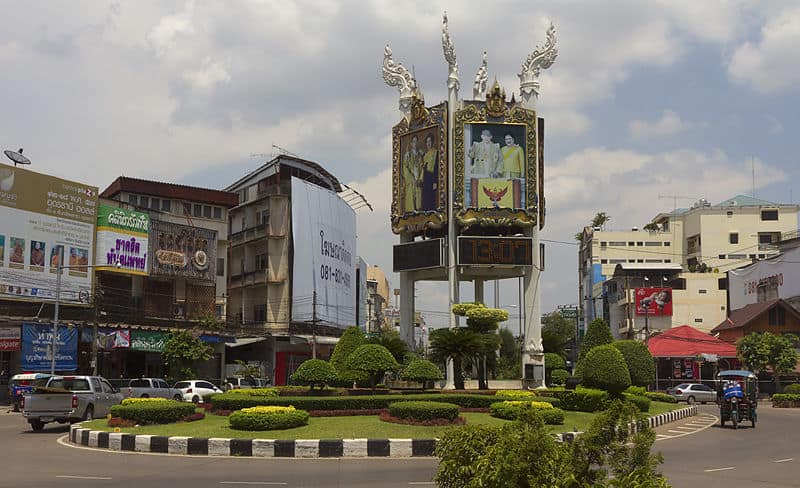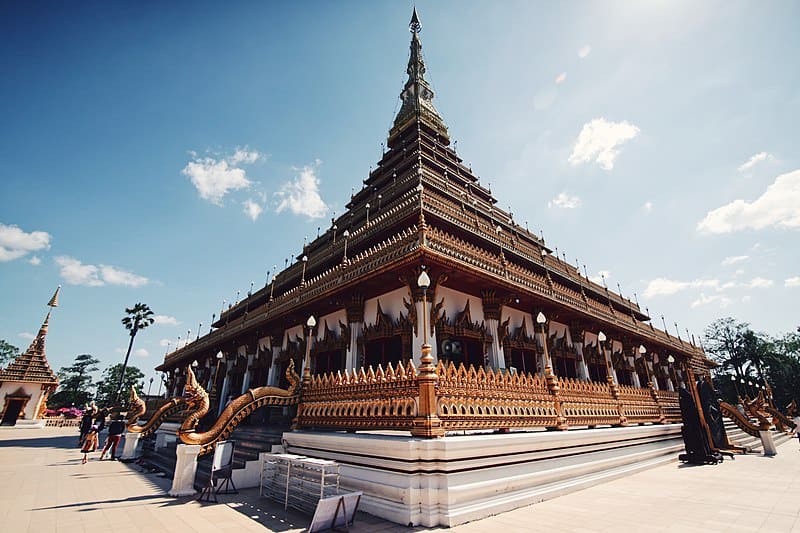The Best Places to Visit in Northeastern Thailand
Compared to the central, southern, and northern regions of Thailand it is fair to say that the volume of tourists who hit the northeastern regions is startlingly low.
And while this may be due in part to poor investment in the area on the part of the Tourism Authority of Thailand (T.A.T), it might also be that the stereotypical idea many would-be visitors may have of the area (if indeed they even consider it at all) is that of a dry, dusty, barren part of the country with nothing much to do but tend to seasonal crops in the blazing tropical heat.
It is certainly true that the majority of the NE region, known alternatively as ‘Isaan’, is indeed agricultural, with rice being the mainstay of the trade that comes out of the area – and it is dry (although still humid) by comparison with the lush Southern regions that often get more than 6 months of rainfall.
In actual fact though, there is quite a lot more to see than one might imagine, especially for anyone wishing to get a more authentic angle on the country – which is 70% rural anyway – and the NE of Thailand can provide some real insights into the lifestyle and nature of the country and the people away from the hi-so fakery of Central Bangkok which is an alien an unrealistic (not to mention unappealing) option for the majority of people originating from the Isaan realms.
Not forgetting of course that the region’s cuisine is some of the most popular and well-known in the country, even for those living in or visiting Bangkok.
For those unfamiliar with Isaan culinary fayre – well, this is not Green Curry country. Some of Thailand’s most well-liked dishes originate from the Northeast in the form of the fiery papaya salad otherwise known as ‘Somtum’. ‘Laab’, which is a spicy, herb and lemon-tinged dish usually made with some form of chopped meat or fish, and eaten with another regional staple ‘khao neow’ (sticky rice) can also be found on tables throughout the country.
So again, taking the trip to this region will provide a more authentic insight into the actual lifestyle of many a Thai than an overpriced Chinese restaurant in Bangkok.
Apparently the NE of Thailand (according to T.A.T figures) accounts for just 2% of the country’s tourism sector. A bizarre fact when considering how many ‘world’ travelers are likely to have a visit to Angkor Wat, the famous Khmer Empire temple in neighbouring Cambodia on their ‘must visit’ list.
The Isaan region of Thailand has strong links with both Cambodia and Laos (which both border the area), and in many ways is rich in still-untouched or widely unheard of Angkor-era temple ruins and artifacts, alongside the natural, outdoor greenery of several national parks.
This is an area that was largely ruled by the Khmers for around a 300-year period from the 10th century onward – around the time of the construction of the remarkable Angkor Wat – meaning that many of the temples and shrines from that period still remain to this day, albeit to varying degrees of ruin or restoration. Yet another little-known fact is that the country’s premier archaeological site (Ban Chiang) is also in the Northeastern region of the country.
It is no secret that much of the population of Bangkok, in fact, hails from Isaan, which is actually home to more than one-third of the entire mass of people in Thailand, with 3 of the largest cities in the country also being in the northeast, namely: Khon Kaen, Udon Thani, and Nakhon Ratchasima (Korat).
Aside from the Cambodian influence, the region is also strongly linked with Laos and its culture, with many from the NE part of Thailand being able to trace their roots back along the Mekhong River to the neighbouring country.
So where to start? Well, as usual, this list is not exhaustive by any means but aims to provide insight, by way of some of the most interesting options, to an aspect of Thailand that is definitely worth checking out in some capacity. After all, everyone has been to Bangkok and the Grand Palace by now – haven’t they?
Udon Thani
Beginning in what might be termed as ‘upper’ Isaan, the city of Udon Thani is easily-accessible by either domestic flight (it has its own airport) or by the slightly longer trek on a train.
This is by no means a sleepy agricultural dry spot – in fact, it is quite a lively area with many attractions, and is also home to a variety of people among its local community including those with Chinese and Vietnamese ancestry, as well as having a fair sprinkling of Western expats.
Here you can find plenty of markets, parks, restaurants, and a few attractions unique to the area such as the ‘Talay Bua Daeng’ (Red Lotus Sea), which is as the name suggests a large water area that blooms with bright red lotus flowers making for a stunning sight.
Nakhon Ratchasima
Largely known as ‘The Gateway to Isaan’ and more commonly by its shortened name of ‘Korat’, Nakhon Ratchasima is basically the first part of the northeast that you will hit when travelling from Bangkok or other central regions.
Home to the vast, natural expanse that is the national park of Khao Yai, this is a popular place for many to head when wishing to escape Bangkok without going too far. Khao Yai contains forest, rivers, waterfalls, and wild animals from elephants to tigers. It is a great place for trekking, camping, climbing, and generally for escaping the madness and urban sprawl of the city in Thailand.
Khao Yai is the third-largest national park in the country and only a couple of hours’ drive from Bangkok. It attracts tourists on day trips or week-long stays and is a popular weekend getaway for native Bangkokians.
Any discerning Westerners may note to their consternation that Thailand’s much-despised dual-pricing policy is in full effect in places like Khao Yai, however, with Westerners, in particular, being targeted for entrance fees that are 10 ten times higher (YES 10 times!) than those for locals and sometimes other Asians. This is the case, unfortunately, across the board in Thailand and is just one of those things that they have yet to catch up with the rest of the world on in terms of fairness and equality – a somewhat sad reflection on the state of affairs in the country for many people who are put off by this.
There is a range of accommodation available around the boundaries of the park – from resorts, guest houses and hotels all with different price ranges. As a general rule of thumb though, it is most likely that the better the views, the higher the prices in this case.
Korat also has a reasonable zoo with a wide range of animals, which also incorporates a themed water park. And if that’s not enough to keep you busy then many of the surrounding and neighbouring areas such as Saraburi are places of natural beauty with mountains, rivers and waterfalls a-plenty for those who don’t mind a bit more driving and exploring.
Nong Khai
Even though it is a rather small province compared to some of the others in the Northeast of Thailand, Nong Khai has much to offer. Its main selling point might just be the fact that it is actually on the border with neighbouring Laos, separated only by a river and a bridge (The Friendship Bridge).
This obviously makes it a popular and useful stop-off point for those planning on a trip to Laos as part of their SE Asian tour, and Nong Khai is also not that far from the domestic airport of Udon Thani.
The relaxed, slow ambience of Nong Khai in a tropical jungle setting along the Mekhong River holds many other charms such as waterfalls, mountain temples and Buddhist statues, as well as festivals involving somewhat supernatural-seeming occurrences such as the Naga Fireballs Festival when magical lights flash and float over the surface of the river, which many still believe are the mythical naga serpents (while others maintain that they are in fact fireflies).
A bit further away from the centre of Nong Khai is ‘Than Thip’, a waterfall of stunning natural beauty. While it may actually take a day trip to visit the waterfall, which is located amidst lush Thai jungle backdrop and is the tallest in the area, it is well worth it.
Another local attraction is the ‘temple of the mountain’ (Wat Phu Tok) which is over 1,000 feet in height and is reachable via seven levels of the mountain that it is situated upon. This number is no accident and is symbolic of the seven levels of enlightenment contained within Theravada Buddhist philosophy. The ladders and steps that form part of the approach may look a little daunting to some, but it’s apparently not as challenging as it looks, with the views at the top making it all worthwhile.
Taking the Theravada theme a step further, at a place called ‘Sala Kaew Ku’ can be found some of the most impressive statues in the country. Here you will find carved and cast depictions of various Buddhist tales and metaphors, such as the Buddha and the seven-headed naga serpent – a common symbol throughout Thailand.
Some of these statues are as high as 25meters, so if you are interested in Thai and Buddhist culture or not, Sala Kaew Ku is an enthralling stop-off on any travel itinerary for this neck of the woods.
Buriram
Buriram is located in lower northeastern Thailand, and is, without a doubt the most rapidly-developing area in the region. This is in no small part due to the sponsorship and patronage of millionaire local businessman Nevin, who has done much to develop the local football club (Buriram Utd) into one of the nation’s finest, built a world-class, FIA grade motor racing track (Chang International Circuit), and generally put the place on the map in recent years.
Buriram is an expansive region with a variety of attractions on offer. The most famous one is probably Phanom Rung Temple (situated in what is classified as acres of National Park).
This Khmer and Hindu influenced site is considered one of the most prominent historic temples in all of South East Asia, least of all in the province of Buriram. Located right on the rim of an extinct volcano, the architectural theme is not dissimilar to that of Cambodia’s Angkor Wat, consisting of intricate, ornate carvings and religious scenes typical of constructions of this design and era.
There is undoubtedly a Khmer link in Buriram, with many of the locals having their roots tracing back in that direction. This means that the Khmer-style architecture is actually commonly found in this province, and there are other, lesser-known examples of temples such as Prasat Muang Tam. This temple is found in the Prakhon Chai district and dates back to a similar era as Phanom Rung (around 10th century).
Image by Yakuzakorat sourced from wiki media commonsKhao Kradong is another forest park in the Buriram region, again situated in what was formerly volcanic landscape. Near the pinnacle of one former volcano is situated a famous Buddha image that can be reached by 400 steps for those feeling energetic enough to make the climb. This is a scenic area that makes for a great day out, with photogenic looking lakes along with the way and of course, most importantly, droves of food sellers.
Khon Kaen
Another developing, reasonably modern-looking province in the Northeastern region, Khon Kaen is classed as one of the four biggest areas in Isaan. It is still not that much of a tourist-oriented area but has the potential to be, as this region is also considered by many as the real gateway to Isaan (as a pose to Korat), and it has much to offer in the way of temples, lakes, markets and restaurants.
Again this is a region rife with ancient Khmer ruins, temples, shrines and monuments. The most prominent is possibly the Prasat Pueai Noi, which is similar in some respects to Buriram’s Phanom Rung, and is based in a compound comprising 3 buildings, surrounded by a moat.
Anyone visiting cities or provinces in the Isaan area will find that by comparison to Bangkok, for instance, the general price of things like food and drink tends to be much lower. Khon Kaen is no exception, and there is no shortage of delights to sample at any of the day and night markets that are commonly found in the more densely populated northeastern regions such as this.
There is also a growing range of restaurants and accommodations to suit various tastes and budgets in Khon Kaen and other similar provinces in the northeastern region of Thailand – so it is definitely something to keep an eye on for any possible planned future trips to the country.
Planning a trip to Paris ? Get ready !
These are Amazon’s best-selling travel products that you may need for coming to Paris.
Bookstore
- The best travel book : Rick Steves – Paris 2023 – Learn more here
- Fodor’s Paris 2024 – Learn more here
Travel Gear
- Venture Pal Lightweight Backpack – Learn more here
- Samsonite Winfield 2 28″ Luggage – Learn more here
- Swig Savvy’s Stainless Steel Insulated Water Bottle – Learn more here
Check Amazon’s best-seller list for the most popular travel accessories. We sometimes read this list just to find out what new travel products people are buying.




















